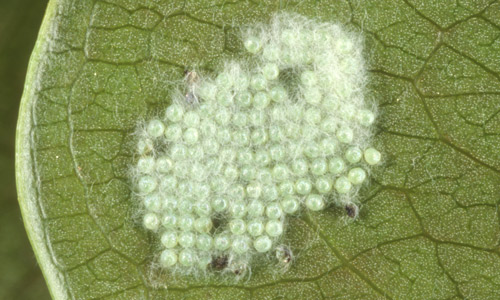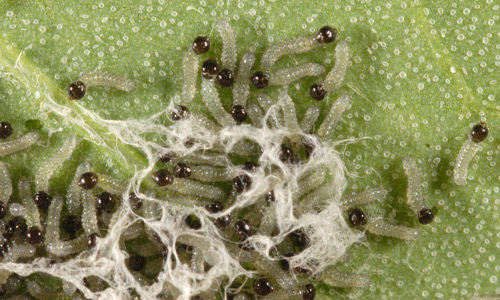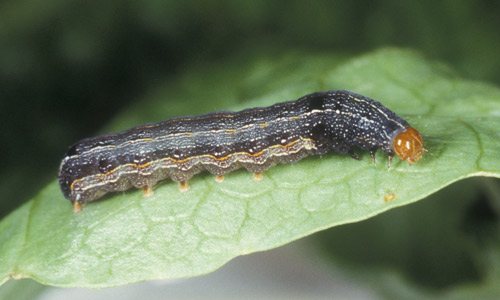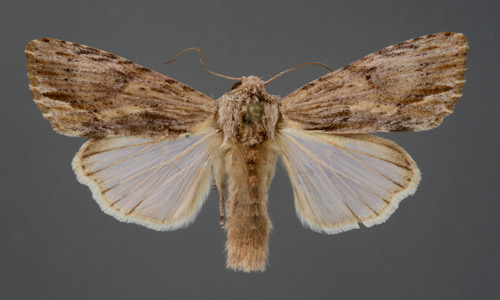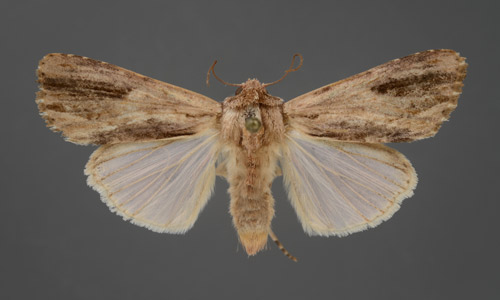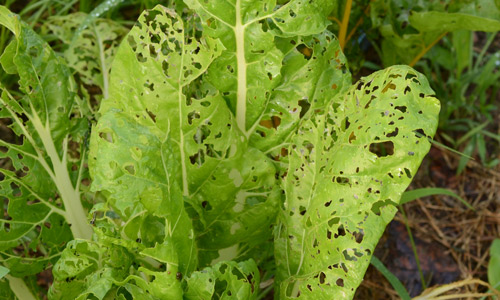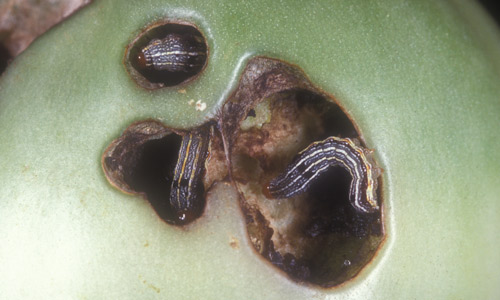common name: southern armyworm
scientific name: Spodoptera eridania (Stoll) (Insecta: Lepidoptera: Noctuidae)
Distribution - Description and Life Cycle - Host Plants - Damage - Natural Enemies - Management - Selected References
Distribution (Back to Top)
The southern armyworm, Spodoptera eridania (Stoll), is native to the American tropics, occurring widely in Central and South America and the Caribbean. In the United States, the southern armyworm is found principally in the southeastern states; its range extends as far west as Kansas and New Mexico. It also is reported from California, but is of no consequence there.
Description and Life Cycle (Back to Top)
The number of generations is estimated at four annually in Florida. In northern Florida moths can be found throughout the year, withstanding several days of freezing weather (Mitchell and Tumlinson 1994). However, larvae are found in northern Florida only in the summer months, and like most insects, are most abundant in the summer. About 30 to 40 days is required for a complete generation.
Eggs: The shape of the eggs is a flattened sphere. Eggs measure about 0.45 m in diameter and 0.35 mm in height. The eggs are greenish initially, turning tan as they age. Eggs are laid in clusters, and covered with scales from the body of the moth. Duration of the egg stage is four to six days.
Figure 1. Eggs of southern armyworm, Spodoptera eridania (Stoll). Photograph by Lyle J. Buss, University of Florida.
Larvae: The larvae undergo six instars as they grow to attain a length of about 35 mm. The head capsule widths are about 0.25-0.30, 0.40-0.50, 0.60-0.80, 0.95-1.15, 1.35-1.85, and 2.35-2.85 mm, respectively (Redfern 1967). Larvae are green or blackish green with a uniform light brown or reddish brown head throughout the period of development, although their color pattern is quite variable. Larger larvae bear a narrow white line dorsally, and additional stripes laterally. Each side normally bears a broad yellowish or whitish stripe that is interrupted by a dark spot on the first abdominal segment, although in some cases this spot is weak. A series of dark triangles is usually present dorsolaterally along the length of the body. Larvae usually are found on the lower surface of leaves, and are most active at night. Duration of the larval stage is normally 14 to 20 days.
Figure 2. Southern armyworm, Spodoptera eridania (Stoll), neonate (newly hatched) larvae on tomato. Photograph by Lyle J. Buss, University of Florida.
Figure 3. Southern armyworm, Spodoptera eridania (Stoll), second and third instar larvae on tomato. Photograph by Lyle J. Buss, University of Florida.
Figure 4. Late instar larva (dark form) of the southern armyworm, Spodoptera eridania (Stoll). Photograph by Lyle J. Buss, University of Florida.
Figure 5. Mature larva (light form) of the southern armyworm, Spodoptera eridania (Stoll). Photograph by John L. Capinera, University of Florida.
Pupae: Larvae pupate in the soil, usually at a depth of 5 to 10 cm. The pupae are mahogany brown in color and measure about 16 to 18 mm in length and 5 to 6 mm in width. Duration of the pupal period is 11 to 13 days.
Adults: The moths measure 33 to 38 mm in wing span. The forewings are gray and brown, with irregular dark brown and black markings. The wing pattern is highly variable, with some individuals bearing a pronounced bean-shaped (reniform) spot near the center of the wing whereas others lack the spot or instead bear a broad black band extending from the center of the wing to the margin. In males, the spot usually takes the form of a dark streak, whereas in females the dark spot is weak or absent. The hind wings are opalescent white.
Figure 6. Adult female of the southern armyworm, Spodoptera eridania (Stoll). Photograph by Lyle J. Buss, University of Florida.
Figure 7. Adult male of the southern armyworm, Spodoptera eridania (Stoll). Photograph by Lyle J. Buss, University of Florida.
The biology of the southern armyworm is poorly documented, but Chittenden and Russell (1910) give key features. Additional description is given by Crumb (1929). The key presented by Levy and Habeck (1976) is useful for distinguishing southern armyworm larvae from related species. A key to the Spodoptera moths of the Western Hemisphere, including this species, is given by Todd and Poole (1980). A sex pheromone has been identified and evaluated in the field (Mitchell and Tumlinson 1994).
Host Plants (Back to Top)
This species has a very broad host range, and includes important vegetable, fruit, field and ornamental crops. Among of the vegetables injured are beet, cabbage, carrot, collard, cowpea, eggplant, okra, pepper, potato, sweet potato, tomato, and watermelon. Other crops damaged include avocado, citrus, peanut, sunflower, velvet bean, tobacco and various flowers. Many weeds are consumed, but pigweed, Amaranthus spp.; and pokeweed, Phytolacca americana; are especially favored. Grasses are rarely eaten. There are numerous reports of armyworm infestations beginning with pigweed and pokeweed, with adjacent crops damaged only after the more favored weeds are consumed.
Damage (Back to Top)
Larvae are defoliators and feed gregariously while young, often skeletonizing leaves. As they mature they become solitary, and also bore readily into fruit, often damaging tomato in Florida. When stressed by a lack of food they will eat the apical portions of branches, bore into stem tissue, and attack tubers near the surface of the soil.
Figure 8. Foliar damage caused by young larva of the southern armyworm, Spodoptera eridania (Stoll). Photograph by Lyle J. Buss, University of Florida.
Figure 9. Tomato fruit feeding injury by the southern armyworm, Spodoptera eridania (Stoll). Photograph by Lyle J. Buss, University of Florida.
Natural Enemies (Back to Top)
Several wasps parasitoids commonly associated with caterpillars of other species, including Cotesia marginiventris (Cresson), Chelonus insularis Cresson, Meteorus autographae Muesebeck, and Meteorus laphygmae Viereck (all Hymenoptera: Braconidae) also attack southern armyworm. Meteorus autographae was the dominant parasitoid in a Florida study (Tingle et al. 1978). Also reared from southern armyworm are Campoletis flavicincta (Ashmead) and Ophion flavidus Brulle (both Hymenoptera: Ichneumonidae); Euplectrus platyhypenae Howard (Hymenoptera: Eulophidae); Choeteprosopa hedemanni Braeur and Bergenstamm, Euphorocera claripennis (Macquart), Gonia crassicornis (Fabricius), Winthemia quadripustulata (Fabricius), and Winthemia rufopicta (Bigot) (all Diptera: Tachinidae).
Undoubtedly predatory insects such as stink bugs (Hemiptera: Pentatomidae) prey on southern armyworm, but this seems to be undocumented. Larvae also are susceptible to infection by the fungus Beauveria bassiana (Gardner and Noblet 1978).
Management (Back to Top)
Southern armyworm is best controlled with foliar insecticides when larvae are small. Insecticides vary considerably in their toxicity to larvae and larvae are difficult to control with botanical insecticides. Berger (1920) reported some success at southern armyworm suppression by application of bran bait containing insecticide. However, this is primarily useful for large, mobile larvae that have left the plant and are on the soil surface.
Selected References (Back to Top)
- Berger EW. 1920. The semitropical armyworm. State Plant Board of Florida Quarterly Bulletin 4: 17-31.
- Capinera JL. 2001. Handbook of Vegetable Pests. Academic Press, San Diego. 729 pp.
- Chittenden FH, Russell HM. 1910. The semitropical armyworm. U.S. Department of Agriculture Bureau of Entomology Bulletin 66: 53-70.
- Crumb SE. 1929. Tobacco Cutworms. U.S. Department of Agriculture Technical Bulletin 88. 179 pp.
- Gardner WA, Noblet R. 1978. Effects of host age, route of infection, and quantity of inoculum on the susceptibility of Heliothis virescens, Spodoptera eridania, S. frugiperda to Beauveria bassiana. Journal of the Georgia Entomological Society 13: 214-222.
- Levy R, Habeck DH. 1976. Descriptions of the larvae of Spodoptera sunia and S. latifascia with a key to the mature Spodoptera larvae of the eastern United States (Lepidoptera: Noctuidae). Annals of the Entomological Society of America 69: 585-588.
- Mitchell ER, Tumlinson JH. 1994. Response of Spodoptera exigua and S. eridania (Lepidoptera: Noctuidae) males to synthetic pheromone and S. exigua females. Florida Entomologist 77: 237-247.
- Redfern RE. 1967. Instars of southern armyworm determined by measurement of head capsule. Journal of Economic Entomology 60: 614-615.
- Tingle FC, Ashley TR, Mitchell ER. 1978. Parasites of Spodoptera exigua, S. eridania (Lep.: Noctuidae) and Herpetogramma bipunctalis (Lep.: Pyralidae) collected from Amaranthus hybridus in field corn. Entomophaga 23: 343-347.
- Todd EL, Poole RW. 1980. Keys and illustrations for the armyworm moths of the noctuid genus Spodoptera Gueneé from the Western Hemisphere. Annals of the Entomological Society of America 73: 722-738.
